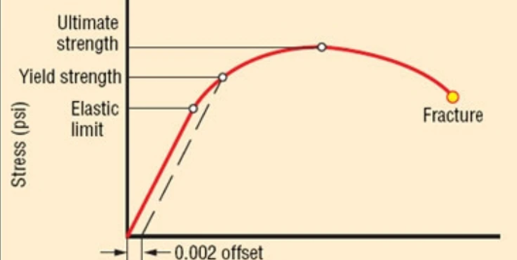
At yield point, Hooke’s law doesn’t hold good
A) True
B) False
Answer
519k+ views
Hint: Hooke’s Law: Hooke’s law states that the strain of the material is proportional to the applied stress within the elastic limit of that material.
Formula used: $F = - k.x$
F = force
x = extension
k = spring constant
Step by step solution:
The yield point is the point on a stress strain curve that indicates the limit of the elastic behavior and the beginning of the plastic behavior. Yielding means the start of breaking of fibers.

Thus, Hooke’s law doesn’t hold good in this region, as stress is not proportional to strain in this region.
Additional information:Hooke's equation holds (to some extent) in many other situations where an elastic body is deformed, such as wind blowing on a tall building, and a musician plucking a string of a guitar. An elastic body or material for which this equation can be assumed is said to be linear-elastic or Hookean. Hooke's law is only a first-order linear approximation to the real response of springs and other elastic bodies to applied forces. It must eventually fail once the forces exceed some limit, since no material can be compressed beyond a certain minimum size, or stretched beyond a maximum size, without some permanent deformation or change of state. Many materials will noticeably deviate from Hooke's law well before those elastic limits are reached.
Note:While solving these types of questions one should have a clear understanding of the stress strain diagram and all the terms involved in it. Sometimes we get confused with terms like elastic and plastic. Both are different terms and we should have a clear understanding of these terms then only we can give a correct answer.
Formula used: $F = - k.x$
F = force
x = extension
k = spring constant
Step by step solution:
The yield point is the point on a stress strain curve that indicates the limit of the elastic behavior and the beginning of the plastic behavior. Yielding means the start of breaking of fibers.

Thus, Hooke’s law doesn’t hold good in this region, as stress is not proportional to strain in this region.
Additional information:Hooke's equation holds (to some extent) in many other situations where an elastic body is deformed, such as wind blowing on a tall building, and a musician plucking a string of a guitar. An elastic body or material for which this equation can be assumed is said to be linear-elastic or Hookean. Hooke's law is only a first-order linear approximation to the real response of springs and other elastic bodies to applied forces. It must eventually fail once the forces exceed some limit, since no material can be compressed beyond a certain minimum size, or stretched beyond a maximum size, without some permanent deformation or change of state. Many materials will noticeably deviate from Hooke's law well before those elastic limits are reached.
Note:While solving these types of questions one should have a clear understanding of the stress strain diagram and all the terms involved in it. Sometimes we get confused with terms like elastic and plastic. Both are different terms and we should have a clear understanding of these terms then only we can give a correct answer.
Recently Updated Pages
Physics and Measurement Mock Test 2025 – Practice Questions & Answers

NCERT Solutions For Class 5 English Marigold - The Little Bully

NCERT Solutions For Class 12 Maths Three Dimensional Geometry Exercise 11.1

NCERT Solutions For Class 11 English Woven Words (Poem) - Ajamil And The Tigers

NCERT Solutions For Class 6 Hindi Durva - Bhaaloo

NCERT Solutions For Class 12 Physics In Hindi - Wave Optics

Trending doubts
1 ton equals to A 100 kg B 1000 kg C 10 kg D 10000 class 11 physics CBSE

Difference Between Prokaryotic Cells and Eukaryotic Cells

One Metric ton is equal to kg A 10000 B 1000 C 100 class 11 physics CBSE

1 Quintal is equal to a 110 kg b 10 kg c 100kg d 1000 class 11 physics CBSE

Proton was discovered by A Thomson B Rutherford C Chadwick class 11 chemistry CBSE

Draw a diagram of nephron and explain its structur class 11 biology CBSE




